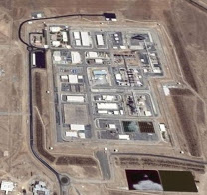After years of negotiation, Iran finally signed a deal with members of the U.N. Security Council to halt any activity that could lead to the creation of nuclear weapons. Sanctions are being lifted and Iran is rejoining the world marketplace. One new business arrangement involves the U.S. purchasing heavy water from Iran. The U.S. does not produce heavy water and has to buy heavy water from foreign suppliers such as Canada and now Iran. The U.S. buys and imports about seventy five tons of heavy water each year.
Most of the hydrogen in ordinary water consists of the isotope with a single proton in the nucleus of the atom. The isotope of hydrogen with a proton and a neutron in the nucleus is referred to as deuterium. Deuterium atoms comprise about .015% of the hydrogen in ordinary water. Water which contains a higher than normal percentage of deuterium is called "heavy water." Heavy water used in nuclear reactors may contain over 99% deuterium atoms. Heavy water was first produced in 1932 a few months after the discovery of deuterium. Heavy water reactors such as the CANDU reactors can burn natural uranium because of the neutron moderating capability of heavy water. Heavy water was extensively used in the early days of research on nuclear reactors. It is currently used in plutonium production, nuclear research and some industrial applications.
Iran built a heavy water reactor at Arak in the early years of the 21st century which was a major concern for those fearing that Iran was working on a nuclear weapons program. Such reactors are useful for producing plutonium that can be used to make nuclear warheads. They have limited utility for other purposes. Iran also constructed a heavy water production plant in Arak to supply heavy water to the Arak reactor. Under the Iran nuclear deal, Iran was forced to modify the Arak reactor to make it much less suitable for the production of plutonium. The heavy water plant is still operating.
Under the Iran nuclear deal, for the near future, Iran has to keep its stockpile of heavy water under one hundred and thirty tons. Later, the stockpile level must be below ninety tons. The U.S. and Iran have been working on finding buyers for Iranian heavy water but have been unsuccessful. Iran's stockpile of heavy water is rising and, unless it is reduced, it will exceed the maximum level established in the deal.
In order to help Iran meet its obligations, the U.S. has just agreed to purchase thirty two tons of heavy water from Iran for eight million six hundred thousand dollars. The U.S. is hoping that its purchase of heavy water will signal to the world that Iran's heavy water is of high quality and that purchasing it is legitimate. U.S. officials have said that they are just helping Iran get started in developing an international customer base that will be necessary if Iran intends to keep producing heavy water.
The heavy water being purchased will be shipped from the Atomic Energy Organization of Iran to the U.S. Oak Ridge National Laboratory (ORNL) in Tennessee in the next few weeks. It will be utilized by the ORNL to conduct experiments involve in the use of neutron to explore the nature of some materials. Some of the heavy water may be sold to other organizations for use in the production of semiconductors and fiber optic equipment.
Critics of the purchase in Congress have asked the Obama administration exactly how they were going to pay for the heavy water. Currently Iran is not allowed to enter the U.S. financial system or conduct business in dollars. The Obama administration is working on how and when to let Iran into the U.S. financial system. The critics also wanted assurances that Iran would not use the money from the purchase to fund weapons related nuclear research or terrorist activities.
Aerial photography of Arak heavy water plant:
